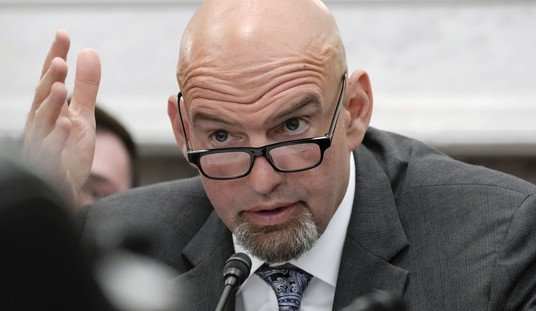This news broke yesterday but it seems more notable on a day when Congress has lost its first sitting member to COVID, Republican Ron Wright of Texas. The good news about the British variant is that the case curve doesn’t slope inexorably upward, of course. In the UK, daily cases have declined 70 percent since the terrifying one-day peak of 68,000 on January 8. (Per capita, that would be tantamount to around 350,000 daily cases in the U.S.) The bad news is that it *is* more contagious than the COVID we’re used to and has already spread more widely in the U.S. than you might think. There’s a real mystery right now as daily vaccinations continue apace whether we’re facing another huge surge as the British variant begins to take over here or whether the growing share of the population that’s been immunized will hold down the daily case counts.
Whatever happens, it’ll happen quickly. The variant is expected to become the most common stain of COVID in the U.S. as soon as next month.
A more contagious variant of the coronavirus first found in Britain is spreading rapidly in the United States, doubling roughly every 10 days, according to a new study…
Dr. Andersen’s team estimated that the transmission rate of B.1.1.7 in the United States is 30 percent to 40 percent higher than that of more common variants, although those figures may rise as more data comes in, he said. The variant has already been implicated in surges in other countries, including Ireland, Portugal and Jordan…
Making matters worse, Dr. Davies and his colleagues at the London School of Hygiene and Tropical Medicine posted a study online on Wednesday suggesting that the risk of dying of B.1.1.7 is 35 percent higher than it is for other variants. The study has yet to be published in a scientific journal.
Genomic sequencing of the virus in the U.S. is pitifully meager compared to some European countries, which is a fancy way of saying that we’re not all that sure what’s circulating here right now. But best guesses about the British variant is that it’s one or two percent of all cases in the U.S. and possibly more than four percent of all cases in Florida, where the state has eschewed lockdowns lately. The media’s quest for evidence that Ron DeSantis has mismanaged the crisis is unceasing so expect that to be the next argument if cases in his state start ticking upward. “Why didn’t the governor lock down again, as the UK did, once he had reason to know that a contagious strain of the virus was spreading in his state?”
But it won’t just be DeSantis next time. Pro Publica published a piece a few days ago wondering why St. Andrew Cuomo, lion of the pandemic, is starting to reopen New York’s restaurants at limited capacity at the very moment a contagious new strain of the disease is beginning to spread in the U.S. One virologist called the move “completely reckless” and said, “I don’t think it’s hyperbolic to say the worst could be yet to come.” Cuomo’s looking at a snapshot in time, what transmission rates in New York look like today, instead of what they’re apt to look like a month from now given the propagation of the new variant. It’s the same mistake he made last March, holding off on shutting down because there were few confirmed cases early in the month and then shutting down too late once he finally grasped the scale of the problem.
New York does have one thing working in its favor. According to a new model of the pandemic, many, many more people have been infected with COVID than have tested positive — on the order of 10 times as many, in fact. That means the U.S. generally and hard-hit spots like NYC in particular are further along towards herd immunity than we might assume, which should limit how bad the next major outbreak can be.

You can look at that data optimistically or pessimistically. The optimistic view is that the virus is running out of people to infect in hot spots. (“They may even be approaching herd immunity there,” said the modeler about New York and North Dakota.) And obviously, if the model’s estimate of the true number of infections is correct, it means the common strain of the virus is less deadly than we thought. The pessimistic view is that, by Fauci’s estimate, we’ll need upwards of 85 percent of a given population to be immune in order to reach herd immunity. That means even North Dakota and New York still have a ways to go — and the British variant, because it’s more contagious, may boost the threshold for herd immunity even higher. There’s also the small matter of certain variants, like the South Africa, seemingly proving able to reinfect people who’ve already survived common COVID. If that virus were to become dominant here, herd immunity might prove impossible until there’s a vaccine tailored to the variant itself:
About 30 percent of the people in the South African [Novavax] trial had antibodies in their blood at the start of the trial showing they had recovered from an earlier infection.
But that previous exposure didn’t necessarily appear to afford protection. Among those who got saltwater shots, the people with a prior infection got sick at the same rate as study participants who had not been previously infected — a surprise because they would have been expected to have some immunity. Nearly 4 percent of people who had a previous infection were reinfected, an almost identical rate to those with no history of infection.
Here’s Scott Gottlieb sounding optimistic about getting boosters for the Brazilian and South African variants by fall, before they’re expected to become prevalent. It’s too late for the British variant, but we don’t actually need a separate booster for that: The current vaccines apparently work just fine against it, as does natural immunity acquired from surviving common COVID. The threat from the UK strain is to the shrinking but still considerable percentage of the U.S. population that hasn’t been infected yet. That’ll shrink a lot more next month, both from vaccinations — two million yesterday! — and from exposure to the variant itself.
Covid vaccine appointments could be made be widely available by April in the U.S., @ScottGottliebMD says. “I think we’re going to run out of demand sooner than we think.” https://t.co/Y4nEQYrJOk pic.twitter.com/wFHAxKxA3P
— CNBC (@CNBC) February 8, 2021







Join the conversation as a VIP Member